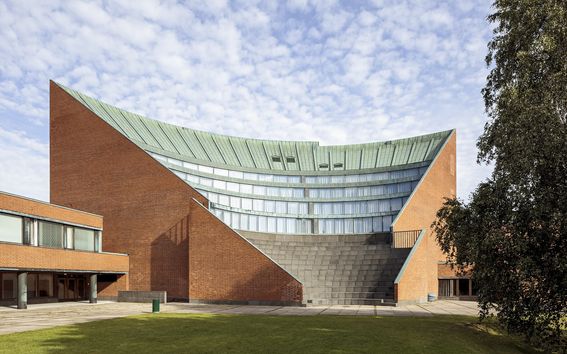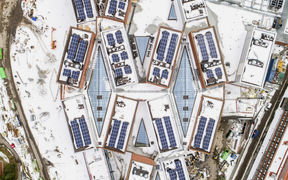Otakaari 1 renovation

During the renovation of Otakaari 1, the architecturally significant building was modernised in terms of indoor facilities and technical requirements to correspond with current standards, without forgetting its notable history.
The landmark of the Otaniemi campus, now Aalto University Undergraduate Centre, was completed in 1964 as the main building of the Helsinki University of Technology. It is regarded as one of the main works of architect Alvar Aalto. Later, the building has been expanded and various modifications have been carried out in its different parts. However, the building has largely maintained its original appearance. Its building systems mainly dated back to the 1960s and were nearing the end of their service life. The aim of the renovation project was to replace all building systems in accordance with current requirements, improve the indoor climate, reduce energy consumption and enhance the availability, safety and accessibility of different facilities.
The renovation of the building was a massive project that was carried out in four phases during 2007–2015. All indoor facilities were renovated and nearly all building systems were modernised. Water pipes and sewers were modernised nearly completely, as were all heating, ventilation, building automation, lighting, electricity, telecom, security and information systems. A central cooling system that uses free cooling represents completely new technology. In addition, the energy efficiency of the external envelope and the ability to control indoor climate conditions were improved and the comfort of the building was increased by enhancing its spatial solutions. The building's French drains were replaced, together with waterproofing and heat insulation in the foundation wall. Special attention was also paid to the fire safety and accessibility of the building.
Energy efficiency enhanced as part of the renovation process
One goal of the renovation project was to improve the building's energy efficiency and indoor climate. The renovation reduced the consumption of heating energy by approximately 37%. In particular, the full replacement of the air conditioning system and its enhancement with an effective heat recovery system and a proper control unit, combined with the new cooling system based on free cooling, reduce energy consumption significantly. In addition, all windows were modernised and all lights were replaced by energy saving fixtures.
As the building is significant both in terms of architecture and cultural history, conservation and protection were key points during the design of the renovation. It was necessary to install new technical systems without altering the appearance of existing structures. The aim was to maintain and repair all existing building parts, wall linings, floor surfaces, fixtures and lights, whenever possible. For example, seats in lecture halls were repaired while respecting the history, even though the seat angle was changed to better serve modern students. All phases of renovation planning were carried out in close cooperation with the Finnish National Board of Antiquities and the Alvar Aalto Foundation.
Sustainable campus
The key environmental impacts of the campus are related to energy consumption and transport. A sustainable and carbon neutral campus is at the core of the campus strategy.







